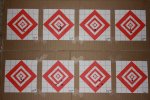The goal is to find a charge where the group doesn't move around even if your powder charge isn't perfect. In your 0.1 string, the 43.0 group is wide because of wind (probably

). 42.8 looks great and 43.2 looks great. It appears that if you chose 43.0 and if your powder charge was anywhere between 42.8 and 43.2, the group would print in the same place. The problems are 42.9 and 43.1. If you have a node at 43.0, then 42.8 through 43.2 should all have the same point of impact and the group size should grow slightly as you move away from 43.0. 43.1 has vertical and 42.9 is too big. And neither of those make sense.
I would reload and reshoot that series.
Pay particular attention to your fundamentals - shoulder position, strong hand grip strength, strong hand thumb position and trigger finger position, trigger pull, and breathing. Make sure that the scope is pointing at the center of the target when the shot breaks. You said that you are using bags made from rice and tee shirts. Be sure that you also have and use a rear bag. The stock fore-end pays in the front bag - remove the front sling attachment. The butt stock lays on the rear bag. Squeeze the rear back harder to raise the buttstock and lower the point of aim.
Make and use wind flags - put three or four garden stakes or other sticks downrange, hang two feet of engineer tape off them. As the wind blows the tape will stream downwind. With no wind, the tape hangs straight down. Light wind the tape starts to stream out downwind. For a given wind speed the angle made by the stake and the tape will be the same. Shoot all your shots at the same angle. If the direction is changing, the tape may stream toward or away from you - this can be tricky but you are not in a hurry.
You want the absolute best possible performance from the gun -- like you were shooting in a warehouse without wind and off a machine rest.
By the way, you certainly could go down to 42.6 but if 43.0 is the center then 42.6 would be an unusually wide node.
One other idea. Just for the heck of it, weigh this brass. You said that it is Lapua. The old Lapua brass was the most consistent I ever saw. But the newer Lapua is not quite as good as the old stuff. It is possible (but unlikely) that 42.9 and 43.1 can be explained by inconsistent brass. My Lapua brass weighs about 71 to 72 grains per case - full prep, no primer. FWIW, Fed 210M primers weight about 4.3 grains each. These days I shoot Lake City LR brass and it weighs between 175 and 182 grains per case. When I load Lapua, it use 42.2 grains of 4064. In order to get the same point of impact with the LC LR brass, I have to reduce my charge to 41.2, 41.0, or 40.8 grains. In my rifle, I get just a smidge over 2,600 fps with those loads. If the brass is the same then either you pulled those shots or your gun is behaving in an unusual way.



